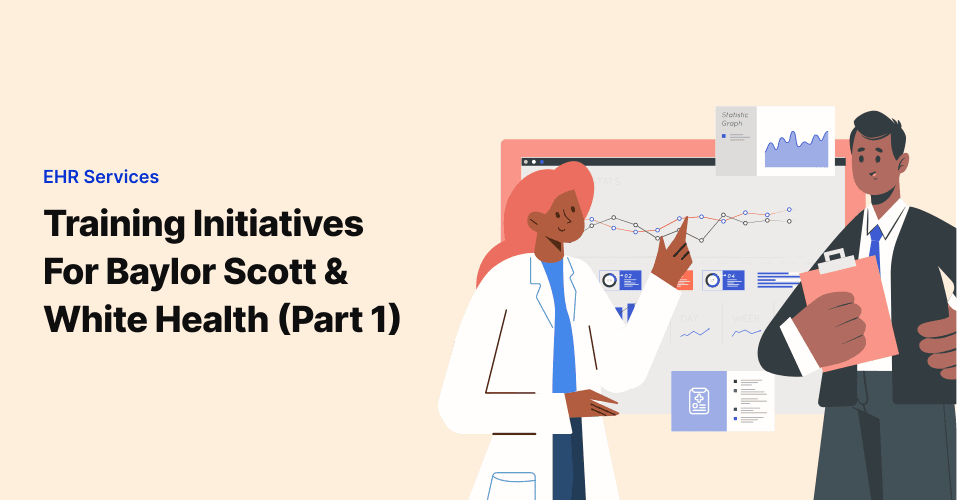
How Training Initiatives Helped Empower and Prepare Baylor Scott and White Health for COVID-19 (Part 1)
Jerrie Rankin, VP of Operational Informatics with Baylor Scott & White Health, and Nicholas Edwards, …

We’ve previously shared some tips for delivering the best Epic training in the healthcare IT space, but as the devil is in the details, we’re going to focus on EHR training materials. There are many “out of the box” tools available on this front, usually from the EHR vendors themselves, but when it comes to encouraging adoption for Epic implementation (or any other EHR), it’s a wise move to up the ante and develop custom training materials. The idea isn’t to recycle existing content; on the contrary, offering fresh ways to reach end users so they pay attention, retain training concepts, and take well to the technology are goals that every member of the EHR implementation team should pursue and support. So, let’s look specifically at a few approaches that will benefit trainers and trainees alike.
While there’s no one who can (in their right mind) argue against the value of in-depth EHR training on systems as complex as Epic, it’s still important to remember that surfacing the most important facts is a great way to reduce the need for re-training and mitigate errors when it comes to Go-live. This is where having a visually-driven EHR quick start guide can be really beneficial. Providing a streamlined training resource that end users can keep close, at the point of care, will go a long way in reinforcing instruction and overcoming roadblocks when it comes to newer workflows. And as much as it pains us to acknowledge, it’s nevertheless prudent to anticipate that some end users will have forgotten their training, show up at Go-live, and ask, “So how do I use this thing?” At the very least, if you can hand over instructions for logging in, retrieving a patient, and starting a note, you’ve covered your basis.
It’s not exactly news that we’re an increasingly visual culture, so the more that video media can be leveraged for EHR training, the better. And just as we mentioned the value of a brief training guide like the quick start guide above, it’s important to keep training videos on Epic and other healthcare IT solutions short and sweet as well. Experts recommend utilizing a series of video tutorials, 3-5 minutes long, versus one mammoth recording that will be difficult to ingest for busy clinicians. In addition, providing visual content such as screen capture of the EHR application in use with relevant voice over is a great way to simulate hands-on experience, and quickly create familiarity with the UI.
Not only do EHR training videos allow for scalable, consistent instruction, but they’re frankly more likely to reach end users where they are. It can be a logistical nightmare to corral masses of physicians, nurses, and other support staff into classroom sessions to support implementation efforts. However, EHR training is a critical component on the road to successful adoption, so finding creative solutions to disseminate information will pay dividends.
How many of us recall the driving motivation for paying attention in class when we were younger as, “Will this be on the test?” The value (or threat) of measuring progress and retention is undeniable, so adult learning principles continue to recommend some aspect of recall or competence evaluation to encourage participation and mastery. Since we just extolled the virtues of video training for EHR implementation, it’s worth mentioning that software solutions like TechSmith’s Camtasia offer embedded quizzes that viewers must engage with to continue through a given module. Hospitals and health systems can identify key workflows or functionality that must be grasped prior to Go-live, and EHR trainers can even monitor results to flag areas of concern (be it a department or workflow).
There’s undoubtedly a theme of simplicity and brevity here, which we’re fully aware is no small ask given the complex nature of EHR solutions for health systems. But it’s worth mentioning that the detailed, hefty EHR user guides absolutely have their place. Someone behind the hospital walls has to understand the password complexity rules, what every dropdown means, and how to account for the various routing options for completed clinical records. An Epic Super User won’t be set up for success with a quick start guide alone; there must be a detailed resource that covers every little nook and cranny. But for most end users, the key is creating accessibility and reducing the time between EHR training and doing.
Join over 3,200 subscribers and keep up-to-date with the latest innovations & best practices in Healthcare IT.

Jerrie Rankin, VP of Operational Informatics with Baylor Scott & White Health, and Nicholas Edwards, …

So, what really is a learning organization? Surprisingly, a clear definition of learning has proved to be …

Like any other plant we are familiar with, the Chinese Bamboo tree requires the usual nourishment such as …